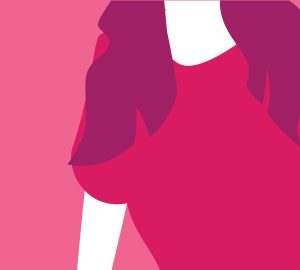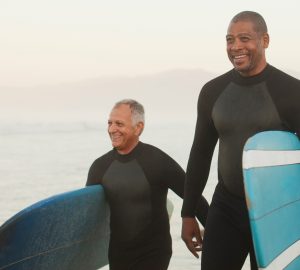When Eos, Greek Goddess of Dawn, asked Zeus to give her lover Tithonus eternal life, she forgot to ask for his eternal youth. It was an oversight with terrible consequences. Today, we still haven’t figured out immortality, but we do have a better idea how to extend our youthfulness and longevity by leading healthier lives. Currently, the average lifespan for a woman in the U.S. is 81 years; for a man, it is 76. But aging is not for the faint of heart. With a longer life ahead of us, there are so many unknowns: What health issues might we have? How will we cope when we are infirm? Who will look after us when we cannot look after ourselves?
down to the bone
Osteoporosis is a disease of aging, which causes bones to become brittle and weak. It affects men and women of all races, but is more common among white and Asian females who are past menopause. According to the National Osteoporosis Foundation, the condition causes bone breakages in 50 percent of women over 50, and up to 25 percent of men over the same age. Fifty-four million Americans have the disease, which commonly leads to hip and spine fractures. Men are less susceptible because their bones are larger and usually stronger, but in women, low estrogen levels, low body fat, breastfeeding and steroids also can cause bone loss, says Dr. Jodie Rai, owner of Women’s Healthcare Consultants. In advanced stages of osteoporosis, even a mild stress such as coughing, bending or reaching can result in a fracture.
Rai cites lower back or neck pain and loss of height as possible indicators of osteoprosis, but Dr. Roberto Civitelli of Washington University’s Musculoskeletal Research Center refers to osteoporosis as ‘The Silent Disease.’ “Unless we test for bone density, doctors can’t see or feel it,” he says. A bone density test is a pain-free scan and the only diagnostic tool. However, Civitelli says there are simple preventive measures that reduce risk. “A healthy lifestyle is very important,” he says. “Inactivity, smoking and drinking, and bad diet all have a negative effect on bone health.”
He recommends any weight-bearing exercise that puts the skeleton in an upright position (for example, walking or jogging), and an intake of foods high in calcium and vitamin D. He says vitamin D is especially important because it is necessary for calcium absorption. “Calcium without D is like overloading a car with a very small engine. It can’t transport all that material,” he explains. Civitelli also stresses that these nutrients are best consumed through food. High levels of calcium are found in collard greens, sardines, ricotta cheese, nuts, milk, tofu and orange juice. Vitamin D is most present in fatty fish.
Rai agrees. “An ounce of prevention is worth a pound of cure,” she says. With lifestyle, supplements and medical therapies, osteoporosis is partly reversible, she notes. Pharmacological options, which either block the breakdown of bones or directly stimulate the cells that produce new bone, also are effective. According to Civitelli, however, an ongoing challenge is treating people properly. “When a person is older and has multiple problems, primary care physicians often don’t consider a fracture to be a high priority,” he says. “Hospitals give excellent care as far as hip replacements, but then the patient is released and gets lost.” He adds that people are becoming more wary of medications and tend to overestimate side effects. “But with bisphosphonates [bone density drugs],” he says, “side effects are very rare.”
in the works
Urogynecology is a sub-specialty of urology and gynecology. While gynecology focuses on menstrual cycles, fibroids and menopause, urogynecology is a treatment—sometimes surgical—for pelvic floor conditions such as female urinary incontinence, overactive bladder, genital and pelvic organ prolapse, and painful bladder conditions. Dr. Mary McLennan is chair of Saint Louis University’s Department of Obstetrics, Gynecology & Women’s Health. Although she has been a urogynecologist for the past 20 years, she says the specialty was not formally recognized by the American Board of Obstetrics and Gynecology until three years ago. Anyone can experience symptoms, but pelvic floor problems are most common in post-menopausal women who have had vaginal births. “Our tissues weaken as we get older. Damage begins with childbirth, but aging makes it worse,” McLennan says, adding that in extreme circumstances, the bladder, bowl or uterus can ‘fall out’ of the vagina by 10 or 12 centimeters. “Essentially, the vagina can turn itself inside out,” she says.
Dr. John Judd, founder of the recently opened Midwest Urogynecology, says up to 10 percent of all women will suffer from prolapse during their lifetime. “Prolapse occurs when the body’s ability to support the organs associated with the pelvic floor is reduced, leading to what can be considered a hernia, or a bulging out of internal tissues,” he says. Symptoms include feeling pressure, a visible protuberance at the vaginal opening, difficulty with urination due to changes in the support mechanism of the bladder or rectum, and sexual dysfunction. It is usually regarded as a progressive disease, but the period between an initial symptom of pressure and the appearance of tissue could be as short as a month. Risk increases with each pregnancy, age, obesity and genetic tissue weakness. Judd says not all pelvic floor conditions can be reversed, but nearly all can be improved with treatments, which range from nonsurgical procedures such as pelvic floor physical therapy, to more involved—usually outpatient—laparoscopic surgeries.
McLennan advises women to reduce their risk of problems by going to the bathroom regularly, avoiding bladder irritants (such as coffee and alcohol), limiting heavy lifting, doing kegel exercises and keeping weight down. She says also that reducing water intake to four or six glasses a day (rather than eight), is beneficial. “It’s a hard life,” Judd says. “Our genetic code is designed only to get us from conception to procreation. After that, we’ve done our job.”
hard decisions
One of the difficult decisions a family has to make is whether to keep an aging relative at home or move them to a senior living community. According to recent research by the American Association of Retired Persons (AARP), nearly 90 percent of seniors want to ‘age in place,’ while only 9 percent expressed a preference for moving to a care facility. (A mere 4 percent would choose to move in with a relative.) Being able to live by their own rules was one of the main reasons the seniors gave. “Given a choice, most older people would choose to stay in a familiar environment,” says Diana Tucker, founder of Private Home Care (PHC). “It is traumatic for them to leave the place they love, where they may have lived for years and raised their children.” Tucker, who has Bulgarian roots, formed her in-home care business two years ago based on a European concept. Each caregiver, she says, stays with the client for at least a year. “They are chosen for their fascinating, well-rounded characters. They are not workers, but companions—people who have a calling,” Tucker says. Consequently, the interview process is thorough. “We vet for similar interests and backgrounds. We want them to feel like companions, like family.”
Tucker currently has 30 caregivers and 24 clients, most of whom receive 24-hour assistance. She says a common misconception is that in-home care is the more expensive option, but that isn’t necessarily the case. PHC is a non-medical service, but caregivers give medication reminders and monitor blood pressure daily.
AccuCare, meanwhile, is an organization of registered nurses that provides in-home services to seniors—from 24-hour, round-the-clock nursing attention to more general help with daily activities such as dressing, meal preparation, housework, looking after pets and transportation. “There is a lot of pride associated with being at home,” says founder Jacque Phillips, R.N. “And often, people can’t conceive of anything else.” Phillips says Relocation Stress Syndrome (RSS) is a condition nurses associate with moving characterized by exhaustion, grief and disorientation. Dementia, if it is present, makes adapting to change especially hard and can be exacerbated by it. She says AccuCare helps clients maintain the highest level of independence by providing a spectrum of services on an hourly basis. “Anything from drawing blood and organizing medication to brushing hair and giving a massage,” Phillips says, adding that nurses are carefully matched to their patients. “If a person is quiet and likes to do the crossword, we don’t pair them with a chatty caregiver. We get a real feel for personalities.”
Phillips says AccuCare employs between 120 and 130 nurses and nurses’ aides for 30 to 50 clients. “Our nurses attend to the whole person—to their mental, physical, emotional and spiritual needs,” Phillips says. “Our seniors have hearts and souls, and we are acutely aware of that.”








